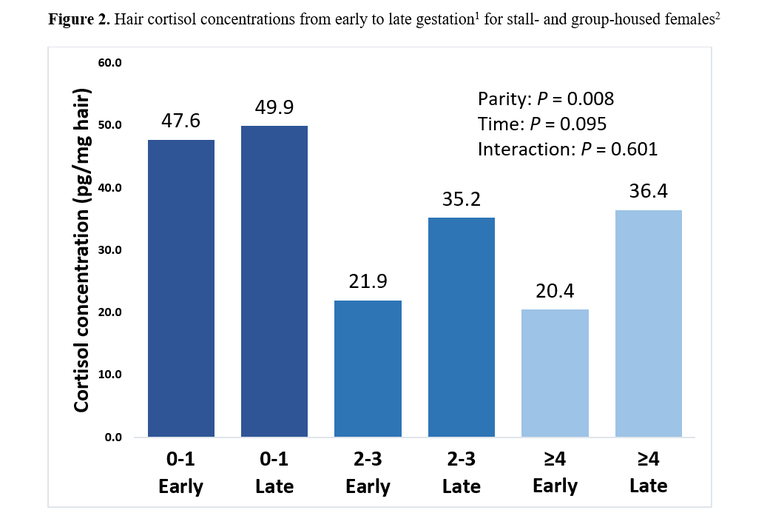Long-term stress in group-housed, stall-housed sows
Study suggests efforts to transition sows into group housing may benefit younger females more than older.
May 19, 2021

There is consumer pressure in the U.S. to ban the use of gestation stalls to improve sow welfare. Welfare and management concerns with group-housed sows related to injuries and stress from fighting has limited widespread adoption of group sow housing in the U.S. Many studies have investigated sow welfare in gestation stalls from the perspective of sow performance, stress-related behavior, and biological indicators of stress, such as the measurement of the hormone cortisol. Cortisol is released into the blood and its concentration fluctuates diurnally and in response to stressors; therefore, blood cortisol may not adequately reflect stress over an extended period of time and may capture the individual stress response to handling during blood collection. Circulating cortisol deposits in growing hair such that periods of stress can lead to higher cortisol in the hair that grew during the stressful experience. Hair cortisol may, therefore, be a better indicator of chronic stress during gestation. The objective of the study was to determine hair cortisol concentrations (HCC) of sows in two different gestation housing systems.
A study was conducted at the South Dakota State University Swine Education and Research Facility using a total of 66 multiparous and primiparous females (PIC 1050). Thirty-four sows were housed in gestation stalls (2 ft x 6.5 ft) from breeding until movement to the farrowing room. Thirty-two sows were moved to one of three pens holding 10-15 sows each (28 ft x 26.9 ft) approximately 48 hours after breeding. Gilts and small parity 1 sows were housed in one pen, and multiparous sows were housed in the other 2 pens. All sows were moved from their assigned housing system to farrowing crates at d111 ± 1.1 of gestation. Hair samples were collected on d37, d74, and d111 of gestation, and samples from d37 (early gestation) and d111 (late gestation) were analyzed for cortisol. Sows were categorized into one of three parity groups, 0-1 (n=23), 2-3 (n=17), and ≥4 (n=26) for parity-specific analysis.
There was an interaction between parity and sow housing where gilts and first parity sows in stall housing had greater HCC than older parity sows also housed in stalls and there was no difference in HCC between females regardless of parity in group pens (Figure 1). Gilts and parity 1 females in stalls had greater HCC than gilts and parity 1 females in group housing (Figure 1).

1 Parity 0-1 refers to gilts and sows that have successfully completed one parity, 2-3 refers to sows successfully completing 2 or 3 parities, and ≥4 refers to sows successfully completing 4 or more parities.
2 Significant difference between means across parities and treatments a, b, c where P ≤ 0.05.
3 0-1 Stall n=11, 2-3 Stall n=10, Stall ≥4 n=13; 0-1 Group n=12, Group 2-3 n=7, Group ≥4 n=13
In late gestation, HCC tended to be greater than in early gestation (P = 0.095) in both stall- and group-housed females. Older parities (≥2) may have a greater HCC increase from early to late gestation, although the difference is not statistically significant (Figure 2).

1 Early gestation refers to the hair grown from d0 (breeding) to d37 of gestation, representing the first third of gestation. Late gestation refers to hair grown from d74 to d111 of gestation, representing the final third of gestation
2 Stalls n=34, Groups n=32
Overall, stall housing appears to be more stressful for gilts and parity 1 sows. However, as sows age they may become more accustomed to stall housing and are less stressed by being restricted than young females. The apparent strong stress response to stall housing, which may persist into their second gestation, suggests that efforts to transition sows into group housing may benefit younger females more than older, more experienced sows. Gilts and parity 1 sows when housed together do not experience higher stress than older females in group housing, suggesting that managing gilts and parity 1 sows together protects gilts from elevated stress during the novel experience of their first gestation. As consumers' expectations and sow welfare standards change in the U.S., more research will be needed to accurately measure sow stress in order to make informed management decisions about the best way to house sows.
Establishing hair cortisol as a consistent measure for long-term stress may be used in conjunction with other measures like sow productivity and behavior in future work for improving sow welfare.
Source: T. Everding, Y. Seddon, J. Perez-Palencia, and C. Levesque, South Dakota State University, University of Saskatchewan, who are solely responsible for the information provided, and wholly owns the information. Informa Business Media and all its subsidiaries are not responsible for any of the content contained in this information asset. The opinions of this writer are not necessarily those of Farm Progress/Informa.
You May Also Like


